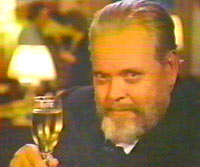Oakland Raiders
vs. Miami Dolphins at the Orange Bowl, September 22, 1975
 There was a lot
of history incumbent on this game, the first one on the Monday night schedule
of 1975. In the 1974 playoffs, the Raiders had dethroned the two-time-champion
Dolphins on the infamous Sea of Hands play, with a tumbling Ken Stabler
finding Clarence Davis for the game-winning touchdown. Subsequent to that, the
Dolphins lost Larry Csonka, Jim Kiick and Paul Warfield to the Memphis
Grizzlies; this would be their first game of the WFL era.
There was a lot
of history incumbent on this game, the first one on the Monday night schedule
of 1975. In the 1974 playoffs, the Raiders had dethroned the two-time-champion
Dolphins on the infamous Sea of Hands play, with a tumbling Ken Stabler
finding Clarence Davis for the game-winning touchdown. Subsequent to that, the
Dolphins lost Larry Csonka, Jim Kiick and Paul Warfield to the Memphis
Grizzlies; this would be their first game of the WFL era.  |
| Blanda, Otto: Chuffed |
For the Raiders,
this was the first game in their entire history without longtime center Jim
Otto, who had moved upstairs to become their business manager. Literally, this was the first Oakland Raiders game that Jim Otto didn't play in. Ever. (Howard Cosell
noted that Otto was now reduced to complaining that dinner for the Raiders cost eighteen
and a half bucks per man.) Otto didn’t exactly retire, and he didn’t get
released: The team just started playing Dave Dalby at center, and let Otto sit
on the sidelines in preseason until he got the message. He must have been
totally chuffed to spend the evening on the sidelines talking to George Blanda,
who was more than ten years older than Otto, but still had a slot on the team. Ray Guy, though, had taken over the kickoff duties.
The two constants for these teams were the coaches, Madden and Shula “his indomitability etched in his visage,” said Guess Who - maybe the most recognizable coaches in the game along with Landry and possibly Noll. The booth team talked about how Madden looked as dapper as ever, but I always thought he dressed like crap, white belt or no.
 |
| Jerry, Betty: Sloshed but unhit |
Actual American
history intruded on the game as well. That afternoon, Sara Jane Moore fired a
shot in the direction of President Ford, following in the footsteps of assassination-minded
babe Lynette “Squeaky” Fromme 17 days earlier, and the broadcast switched to
Harry Reasoner for a full report at halftime. (This wasn’t on the tape I
watched.) In the fourth quarter, ABC News broke away from the game to show President Ford
addressing the press corps about the situation, a visibly sloshed Betty at his
side, as we missed the guts of an ultimately futile Dolphins comeback drive.
This was Alex
Karras’ second year in the MNF booth, and he had become the Otis Sistrunk bureau chief,
after famously declaring Otis a graudate of the University of Mars the year before. In
reality, Sistrunk, who grew up in a very poor family, was lucky to finish high
school and had to go to work in a warehouse when he otherwise might have been
playing college ball. Of course, Cosell needled Karras into saying something
every time Sistrunk – his jersey majestically untucked- did something in the
game, which he did with great regularity.
The game itself was
kind of anticlimactic: The Raiders jumped out to a 17-0 lead, then held on for
a 31-21 victory. Despite the legendary MNF production values, the broadast
itself wasn’t very good. At the end of the third quarter, with the Dolphins
mounting a furious comeback, Miami receiver Howard Twilley caught a pass right
at the goal line as he was coming back toward Bob Griese. It looked like a
touchdown to me – Howard Cosell belatedly agreed – but the ball was spotted at
the one. Incredibly, there was no replay of any kind until after Don Nottingham
crashed across the goal line on the next play, and then it was only the same
inconclusive angle from which we had originally seen the play. They did however, get a good shot of a Dolphin assistant trainer, coming on to help Nat Moore off the field, wearing cutoff denim shorts. Hey, it was the '70s.
The broadcast's one shining moment was a brief segment with William Shatner in the
booth. Shatner, fresh off his triumphant turn in Big Bad Mama, was starring in
a new ABC series called Barbary Coast, which had premiered two weeks earlier.
It didn’t even last as long as the NFL season.









